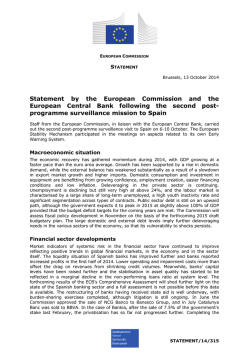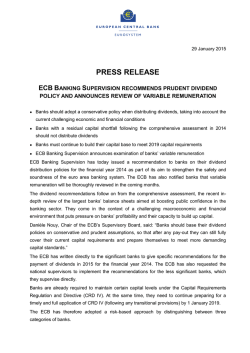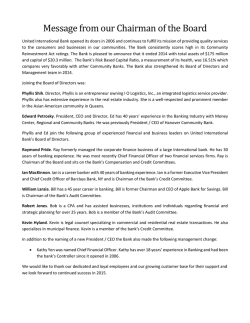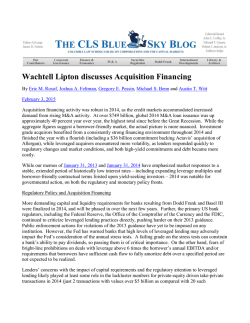
TLAC
2015-02-02 Financial Stability Board [email protected] Joint response to FSB consultation on Total Loss Absorbency Capacity (TLAC) The Swedish Bankers' Association, the Danish Bankers’ Association, the Federation of Finnish Financial Services, Finance Norway, the Association of Lithuanian Banks, the Association of Commercial Banks of Latvia and the Estonian Banking Association support the view of the European banking industry reflected in the European Banking Federation's (EBF's) response to the FSB consultative document on Total Loss Absorbency Capacity (TLAC). In our view, it is important that the new regulatory framework on Total Loss Absorbency Capacity is flexible enough to take into account different banking models, different corporate structures and different regulatory regimes when it comes to capital adequacy, crisis intervention, recovery and resolution and other measures for addressing systemic risk and too big to fail. Against this background, there are a couple of key messages in the EBF's consultation response that we would like to elaborate further. The fundamental assumptions in TLAC do not sufficiently take into account the regulatory reform after the crisis The TLAC proposal implies a reasoning where rule makers and authorities are expected to assess a potential loss in resolution as one single number, representing the worst loss that could arise in a crisis for a single bank. This represents a simplistic and mechanistic way of thinking of potential losses for banks. Losses that are large enough to consume most of the capital in a bank are both rare and unlikely. To assess the likelihood and potential size of further losses over and above the level of the total capital is virtually impossible. The need for loss absorbing capital in a bank will always in practice be a gradual scale, where the probability of the loss to occur will decrease as the size of the losses increases. Regulatory bodies should instead seek to strike an appropriate balance between a very unlikely event occurring, how costly it is to the economy to require higher capital and convertible 2 (5) debt buffers, and the fact that some national authorities have taken measures much more stringent than the international and EU standards to strengthen financial stability further at national level. In addition, the most adequate starting point for assessing potential losses is the minimum capital requirement, rather than more arbitrary measures such as the leverage ratio. Furthermore, the ongoing review within the Basel Committee of the standardized approach and the consultation on introduction of capital floors in the internal ratings based approach may affect banks with low risk weights severely. This aspect should be taken into account when the final TLAC levels are calibrated. Buffer capital and senior debt is not eligible to count towards TLAC TLAC requires that all regulatory capital is entirely rebuilt, so that investors regain confidence in the bank and it can fund itself in the market again. This requirement applies also to the capital buffers in Basel III and the G-SIBs surcharge. Therefore capital held against the capital conservation buffer and the countercyclical buffers can not be used to meet TLAC. According to this principle, banks in jurisdictions with capital buffer requirements much higher than the international standard will be unduly punished. To avoid this, we recommend the FSB to provide flexibility to national authorities to allow the national capital buffers that go beyond the international standards to be used to meet the TLAC requirement. The proposal not to accept senior debt (other than issued at holding company level – provided that there is no other debt on the balance sheet of the holding company), clearly discriminates banking groups with an operating company at the top. Such banking groups would have to issue large quantities of new types of highlysubordinated debt, which would most likely increase significantly the funding costs for those banks. We advocate a TLAC rules text which is neutral when it comes to corporate structure as there is no empirical evidence showing that operationally integrated banking groups, with an operating company at the top, are more risky than the banking groups with a holding company at the top. The choice of different corporate structures for banks in different jurisdictions are rather a result of institutional factors, such as tax systems, corporate laws etc.,to which international regulation should be neutral. Furthermore, the exemption for senior unsecured debt, which is not subordinated contractually or issued from a Holdco, to be counted towards TLAC is conditioned upon the ability of the competent authorities to ensure such liabilities could be written-down without a material risk of successful legal challenge or valid compensation claims. This requirement, as written, will make it difficult to apply the exemption, especially in certain jurisdictions. A number of European jurisdictions have strong statutory frameworks which enable enforcement of agreements, as well as a tradition of doing so based on these frameworks. For this reason, it should be made explicitly clear in the term sheet, that as long as authorities are satisfied that 3 (5) they would be able to cope with NCWOL restrictions based on their legal frameworks, the entirety of the senior unsecured debt should qualify as TLAC. The expectation that 33% of the requirement should be met with debt, will become restrictive if outstanding senior debt cannot be used to fulfil it. It is especially difficult to comply with for banks in jurisdictions with higher than normal capital requirements applied at national level, especially when those requirements are targeting the common equity tier one ratio. The idea that there might be circumstances where it is better to have debt rather than equity as loss absorbing capital is very hard to justify. Therefore, the FSB term sheet should clearly and explicitly state that it is not a hard requirement and that it does not apply to internal LAC. The "twice the leverage ratio" proposal creates a new standardized regime, setting risk assessment out of play The leverage ratio, when first proposed by the Basel Committee, was designed as a backstop, and not intended to set the risk based approach, on which the banks IRB models are based, out of play. The leverage ratio would serve as a backstop for the risk weighting used in the capital requirement regulation, but was never intended to become the primary binding requirement for a significant number of banks. However, with a TLAC based on twice the leverage ratio, this requirement may, for many banks addressed by the TLAC proposal, become the binding requirement, "overriding" the RWA based requirement. A doubled leverage ratio overriding the RWA based capital requirements incentivizes banks, with relatively large balance sheets relative to their RWA, to take on more risk, rather than carefully assessing its risk and pricing them correctly. Therefore, the approach will favour banking models largely built on asset securitization, as opposed to those models where low risk assets are kept on the balance sheet of the bank. This is not an attractive feature of the TLAC requirement when it comes to securing global financial stability. In our view, risks in systemically important banks are best supervised when kept on the balance sheet, and being subject to thorough supervisory scrutiny, rather than when transferred to other parts of the financial system that are not under explicit supervision. In this regard, we recommend that the national regulatory authorities should have the possibility to waive the twice the leverage requirement as the basis for TLAC, if the business model can be proven to consist of low-risk and collateralized assets. Unequal treatment of ex ante financed resolution funds The FSB proposes that resolution funds could be eligible to up to 2.5 per cent of risk weighted assets if certain strict conditions are complied with. As we interpret the proposed term sheet, those strict conditions are not applicable to e.g. the conditions 4 (5) for resolution funds set up in the EU. Several of the Nordic / Baltic countries, e.g. Norway and Sweden, have substantial amounts of capital that have been built up in funds to ensure financial stability. In the case of Sweden the capital will be partly transferred into a resolution fund. The Swedish financing arrangements that can be drawn on in the event of a crisis amount to almost 7 per cent of guaranteed deposits (DGS, stability fund and resolution fund in total). We therefore regret that the FSB term sheet stipulates such strict conditions so that only very few of the jurisdictions with ex ante funded financing arrangements can count them towards TLAC. In our view, this does not contribute to creating a global level playing field amongst G-SIBs. Severe consequences to have TLAC as a minimum binding requirement The FSB proposes the TLAC as a minimum binding requirement, i.e., measures will be taken if the minimum TLAC requirement is breached. In case of a liquidity crisis, banks will have difficulties to refinance their TLAC instruments. In order to meet the minimum TLAC requirement, banks need, or will be required by national authorities, to take other measures such as reducing the balance sheet and potentially imposing distribution restrictions. This will send a signal to the market that the bank is under stress and make it even more difficult for the bank in question to refinance the TLAC instruments. This is in particular the case if the TLAC requirement is based on the leverage ratio requirements. To avoid these destabilizing pro-cyclical consequences, we recommend the FSB to allow banks sufficient time to restore their TLAC instruments without triggering measures that make it even more difficult for banks to meet the TLAC requirement. Conclusions All in all, we regret that the FSB has chosen to create a global standard with which certain banking systems are already more or less fully compliant, whereas others will clearly have to issue large amounts of debt, change their business model (and go from straight forward market funding to securitization) and/or change their corporate structure. It is especially regretful that all the extensive measures taken at the local level (build-up of ex ante financed funds, substantially higher capital requirements, early roll out of Basel III liquidity requirements, etc.) are ignored and put out of play through the lack of flexibility in the proposed term sheet. It would be preferable to focus on the desired functional objectives rather than focusing on providing a detailed and prescriptive term sheet. The term sheet approach ignores the very big differences across the legal systems in which it must be implemented and has the very undesirable feature that it is designed to one specific legal structure. For questions, please contact Johanna Orth, Swedish Bankers’ Association [email protected] + 46 70 5556823 5 (5) Thomas Östros Piia-Noora Kauppi Jørgen A. Horwitz Erik Johansen Mārtiņš Bičevskis Katrin Talihärm Stasys Kropas
© Copyright 2025







